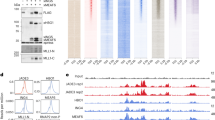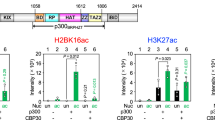Abstract
Jun dimerization protein-2 (JDP2) is a component of the AP-1 transcription factor that represses transactivation mediated by the Jun family of proteins. Here, we examine the functional mechanisms of JDP2 and show that it can inhibit p300-mediated acetylation of core histones in vitro and in vivo. Inhibition of histone acetylation requires the N-terminal 35 residues and the DNA-binding region of JDP2. In addition, we demonstrate that JDP2 has histone-chaperone activity in vitro. These results suggest that the sequence-specific DNA-binding protein JDP2 may control transcription via direct regulation of the modification of histones and the assembly of chromatin.
This is a preview of subscription content, access via your institution
Access options
Subscribe to this journal
Receive 12 print issues and online access
$189.00 per year
only $15.75 per issue
Buy this article
- Purchase on Springer Link
- Instant access to full article PDF
Prices may be subject to local taxes which are calculated during checkout





Similar content being viewed by others
References
Strahl, B.D. & Allis, C.D. The language of covalent histone modifications. Nature 403, 41–45 (2000).
Turner, B.M. Cellular memory and the histone code. Cell 111, 285–291 (2002).
Chakravarti, D. et al. A viral mechanism for inhibition of p300 and PCAF acetyltransferase activity. Cell 96, 393–403 (1999).
Hamamori, Y. et al. Regulation of histone acetyltransferases p300 and PCAF by the bHLH protein Twist and adenoviral oncoprotein E1A. Cell 96, 405–413 (1999).
Weissman, J.D. et al. HIV-1 tat binds TAFII250 and represses TAFII250-dependent transcription of major histocompatibility class I genes. Proc. Natl. Acad. Sci. USA 95, 11601–11606 (1998).
Creaven, M. et al. Control of the histone-acetyltransferase activity of Tip60 by the HIV-1 transactivator protein, Tat. Biochemistry 38, 8826–8830 (1999).
Barlev, N.A. et al. Repression of GCN5 histone acetyltransferase activity via bromodomain-mediated binding and phosphorylation by the Ku-DNA-dependent protein kinase complex. Mol. Cell. Biol. 18, 1349–1358 (1998).
Kitabayashi, I. et al. Phosphorylation of the adenovirus-associated p300 kDa protein in response to retinoic acid and E1A during the differentiation of F9 cells. EMBO J. 14, 3496–3509 (1995).
Ait-Si-Ali, S. et al. Histone acetyltransferase activity of CBP is controlled by cycle-dependent kinases and oncoprotein E1A. Nature 396, 184–186 (1998).
Kawasaki, H. et al. ATF-2 has intrinsic histone acetyltransferase activity which is modulated by phosphorylation. Nature 405, 195–200 (2000).
Seo, S.B. et al. Regulation of histone acetylation and transcription by INHAT, a human cellular complex containing the Set oncoprotein. Cell 104, 119–130 (2001).
Kawase, H. et al. NAP-1 is a functional homologue of TAF-1 that is required for replication and transcription of the adenovirus genome in a chromatin-like structure. Genes Cells 1, 1045–1056 (1996).
Okuwaki, M. & Nagata, K. Template-activating factor-I remodels the chromatin structure and stimulates transcription from the chromatin template. J. Biol. Chem. 273, 34511–34518 (1998).
Aronheim, A., Zandi, E., Hennemann, H., Elledge, S.J. & Karin, M. Isolation of an AP-1 repressor by a novel method for detecting protein-protein interactions. Mol. Cell Biol. 17, 3094–3102 (1997).
Broder, Y., Katz, S. & Aronheim, A. The Ras recruitment system, a novel approach to the study of protein-protein interactions. Curr. Biol. 8, 1121–1124 (1998).
Jin, C. et al. Identification of mouse Jun dimerization protein 2 as a novel repressor of ATF-2. FEBS Lett. 489, 34–41 (2001).
Piu, F., Aronheim, A., Katz, S. & Karin, M. AP-1 repressor protein JDP-2: Inhibition of UV-mediated apoptosis through p53 down-regulation. Mol. Cell Biol. 21, 3012–3024 (2001).
Jin, C. et al. JDP2, a repressor of AP-1, recruits a histone deacetylase 3 complex to inhibit the retinoic acid-induced differentiation of F9 cells. Mol. Cell Biol. 22, 4815–4826 (2002).
Ostrovsky, O., Bengal, E. & Aronheim, A. Induction of terminal differentiation by the c-Jun dimerization protein, JDP2, in C2 myoblasts and rhabdomyosarcoma cells. J. Biol. Chem. 277, 40043–40054 (2002).
Hwang,, H.C. et al. Identification of oncogenes collaborating with p27Kip1 loss by insertional mutagenesis and high-throughput insertion site analysis. Proc. Natl. Acad. Sci. USA 99, 11293–11298 (2002).
Heinrich, R., Livne, E., Ben-Izhak, O. & Aronheim, A. The c-Jun dimerization protein 2 inhibits cell transformation and acts as a tumor suppressor gene. J. Biol. Chem. 279, 5708–5715 (2004).
Wardell, S.E., Boonyaratanakornkit, V., Adelman, J.S., Aronheim, A. & Edwards, D.P. Jun dimerization protein 2 functions as a progesterone receptor N-terminal domain coactivator. Mol. Cell Biol. 22, 5451–5466 (2002).
Ogryzko, V.V., Schiltz, R.L., Russanova, V., Howard, R.H. & Nakatani, Y. The transcriptional coactivators p300 and CBP are histone acetyltransferases. Cell 87, 953–959 (1996).
Munakata, T., Adachi, N., Yokoyama, N., Kuzuhara, T. & Horikoshi, M. A human homologue of yeast anti-silencing factor has histone-chaperone activity. Genes Cells 5, 221–233 (2000).
Umehara, T., Chimura, T., Ichikawa, N. & Horikoshi, M. Polyanionic stretch-deleted histone chaperone cia1/Asf1p is functional both in vivo and in vitro. Genes Cells 7, 59–73 (2002).
Wells, J.A. Systematic mutation analyses of protein-protein interfaces. Methods Enzymol. 202, 390–411 (1991).
Kitabayashi, I. et al. Transcriptional regulation of the c-jun gene by retinoic acid and E1A during differentiation of F9 cells. EMBO J. 11, 167–175 (1992).
Makowski, A.M., Dutnall, R.N. & Annunziato, A.T. Effects of acetylation of histone H4 at lysines 8 and 16 on activity of the Hat1 histone acetyltransferase. J. Biol. Chem. 276, 43499–43502 (2001).
Carrozza, M.J., Utley, R.T., Workman, J.L. & Cote, J. The diverse functions of histone acetyltransferase complexes. Trends Genet. 19, 321–329 (2003).
Dou, Y. et al. Physical association and coordinate function of the H3 K4 methyltransferase MLL1 and the H4 K16 acetyltranferase MOF. Cell 121, 873–885 (2005).
Taipale, M. et al. hMOF histone acetyltransferase is required for histone H4 lysine 16 acetylation in mammalian cells. Mol. Cell Biol. 25, 6798–6810 (2005).
Fraga, M.F. et al. Loss of acetylation at Lys16 and trimethylation at Lys20 of histone H4 is a common hallmark of human cancer. Nat. Genet. 37, 391–400 (2005).
Shibahara, K. & Stillman, B. Replication-dependent marking of DNA by PCNA facilitates CAF-1-coupled inheritance of chromatin. Cell 96, 575–585 (1999).
Moggs, J.G. et al. CAF-1-PCNA-mediated chromatin-assembly pathways triggered by sensing DNA damage. Mol. Cell Biol. 20, 1206–1218 (2000).
Tagami, H., Ray-Gallet, D., Almouzni, G. & Nakatani, Y. Histone H3.1 and H3.3 complexes mediate nucleosome-assembly pathways dependent or independent of DNA synthesis. Cell 116, 51–61 (2004).
Brownell, J.E. & Allis, C.D. An activity gel assay detects a single, catalytically active histone acetyltransferase subunit in Tetrahymena macronuclei. Proc. Natl. Acad. Sci. USA 92, 6364–6368 (1995).
Lomvardas, S. & Thanos, D. Modification of gene expression programs by altering core promoter chromatin architecture. Cell 110, 261–271 (2002).
Pfeifer, G.P. & Riggs, A.D. Chromatin differences between active and inactive X chromosomes revealed by genomic footprinting of permeabilized cells using DNase I and ligation-mediated PCR. Genes Dev. 5, 1102–1113 (1991).
Acknowledgements
The authors thank V. Calhoun, K. Itakura, G. Gachelin, H. Ugai, Y. Shinozuka, M. Kimura, J. Svejstrup, K. Ura, J.L. Workman, K. Ikeda and G. Felsenfeld for reagents and/or many helpful discussions, suggestions and critical reading of the manuscript. This work was supported by grants from the RIKEN Bioresource Project and by a grant from the Ministry of Education, Culture, Sports, Science and Technology of Japan (to K.K.Y.).
Author information
Authors and Affiliations
Corresponding author
Ethics declarations
Competing interests
The authors declare no competing financial interests.
Supplementary information
Supplementary Fig. 1
Characterization of the HAT assay (PDF 337 kb)
Supplementary Fig. 2
His-JDP2 has INHAT activity (PDF 244 kb)
Supplementary Fig. 3
Interactions between reconstituted mononucleosomes and JDP2 (PDF 225 kb)
Supplementary Fig. 4
The purity and stability of wild-type JDP2 and its derivatives (PDF 98 kb)
Rights and permissions
About this article
Cite this article
Jin, C., Kato, K., Chimura, T. et al. Regulation of histone acetylation and nucleosome assembly by transcription factor JDP2. Nat Struct Mol Biol 13, 331–338 (2006). https://doi.org/10.1038/nsmb1063
Received:
Accepted:
Published:
Issue Date:
DOI: https://doi.org/10.1038/nsmb1063
This article is cited by
-
Dimethyl sulfoxide stimulates the AhR-Jdp2 axis to control ROS accumulation in mouse embryonic fibroblasts
Cell Biology and Toxicology (2022)
-
Genotoxic stress-triggered β-catenin/JDP2/PRMT5 complex facilitates reestablishing glutathione homeostasis
Nature Communications (2019)
-
Identification of four differentially methylated genes as prognostic signatures for stage I lung adenocarcinoma
Cancer Cell International (2018)
-
JDP2 overexpression provokes cardiac dysfunction in mice
Scientific Reports (2018)
-
Endoglin integrates BMP and Wnt signalling to induce haematopoiesis through JDP2
Nature Communications (2016)



